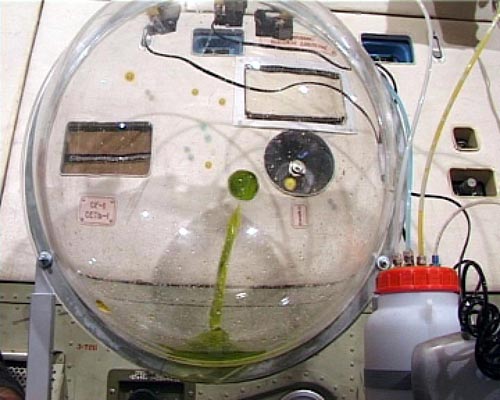Vadim Fishkin, Livia Pàldi – Kaplegraf 0g (drops orbits) – 2003
Vadim Fishkin : Artist, Livia Pàldi : Scenographer
First publication symposium Visibility – Legibility of Space Art. Art and Zero G. :
the experience of parabolic flights, in collaboration with the @rt Outsiders
festival, Paris, 2003

Kaplegraf 0g © Vadim Fishkin
I still remember what a longlasting impression a black and white telecast from a Soviet space station made on me as a child. I especially recall the moment when a cosmonaut poured out/spilled water from a glass. Its suspence and transformation into amorph shapes into different oblong drops captured my attention so much that I forgot about the people levitating around.
Then many years later it was all back with a Stanislaw Lem novel. The report I recollect was of extraterrestrials from Venus which described material civilisation with amazing accuracy but failed to recognize people as individuals and creators of all. Instead it talked about particles of some strange homogeneous soft mass from which they had continuously been separating in a shape of oblong drops. It remained a puzzling substance — a form retaining information — they couldn’t decipher in connection to the enviroment.
The decision to use water is very much linked to some recent scientific research that proved water to be keeper and compiler of information — the almost ready biocomputer. The first basic and surprising fact was the detection of large stable vectorially symmetric formations of fifty seven molecules of water representing dodecahedral tetraheders that are constructed according to the equiprobabilism principle of the linkage of molecules of the water. The question of decoding telepathy, telecines and other unusual phenomena with the proof of possible interaction between water’s information system, water and vacuum has already been acknowledged as a topic and problem of science.
The Kaplegrafs are devices, which can translate data into « water drops » language and use water to convey meanings that transcend normal linguistic conventions. The word is a contraction of the word meaning « drop » in Russian and « -graph » an element borrowed from Greek, meaning « drawn, » « written » and more specialised in meaning to indicate the instrument rather than the written product of the instrument. In the Valencia installation Kaplegraf (techet reka Volga) 30 « drop devices » were following a cult song about the river Volga. With Kaplegraf (drops of reason) the visitor was invited to make the device « communicate » via a personal computer. It learns to solve the given mathematical operation (adding up) and tells the result in its computer generated voice followed by the demanded number of drops falling into transparent bowls. The intensified sound of the drops dominate the exhibition space from time to time arousing tension between the « romantic » atmosphere of the shower of water drops and the programmed character of the spectacle triggered by visitors.
While in gravity condition Kaplegraf translates a very a time based substance (sound/voice) into a more corporeal but still ephemeral substance (drops of water) in zero gravity situation the drops remain in the space and this condition allows for their more visible and material appearance. Kaplegraf (drops orbits) was built with a specially made plastic ball, containers with the constant pressure and special valves, a notebook PC and a video camera (fixed together with the ball). The coloured drops were programmed to « visualize » sequences of Johann Strauss’ Blue Danube while levitating around in elliptical paths.
© Vadim Fishkin et Livia Pàldi & Leonardo/Olats, October 2003 / republished 2023
Leonardo/Olats
Observatoire Leonardo des Arts et des Techno-Sciences
À propos / About | Lettre d'information Olats News



Pour toute (re)publication, merci de contacter / For any (re)publication, please contact Annick Bureaud: info@olats.org
Pour toute question concernant le site, merci de contacter / For any issue about the website, please contact: webmaster@olats.org
Design Thierry Fournier
© Association Leonardo 1997-2022